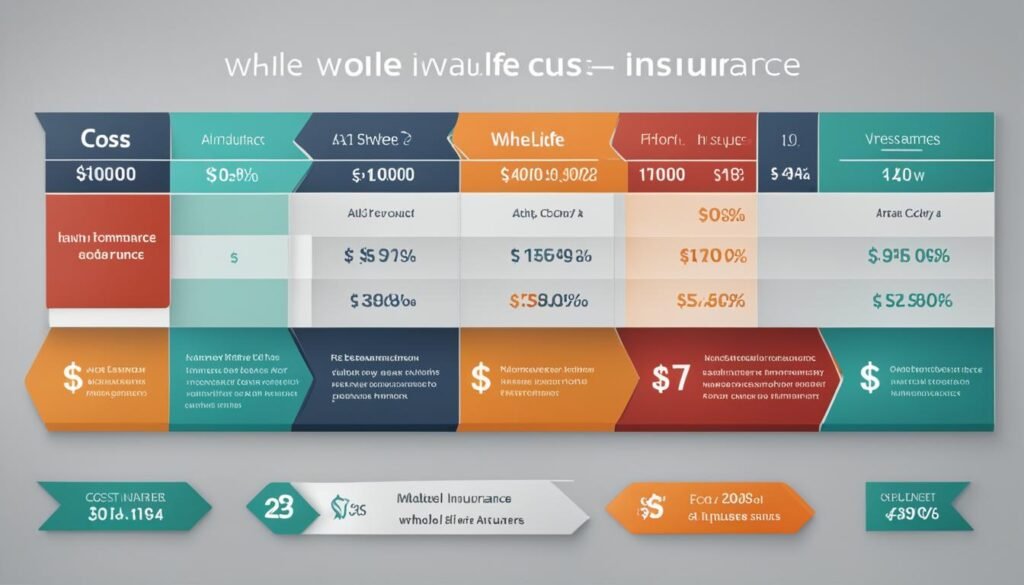When it comes to securing permanent life insurance coverage, understanding the factors that influence whole life insurance policy prices is crucial. The cost of a whole life insurance policy is determined by various variables, including mortality, interest, and expenses.
Mortality tables are used by insurance companies to estimate the average life expectancy for different age groups. These tables play a significant role in determining the premium rate of a policy. Additionally, the interest earnings from invested funds contribute to the price of the policy. As the insurance company invests these funds, they generate returns that help offset the cost of providing coverage.
Expenses incurred by the insurance company, such as operational costs and administrative fees, are also factored into the premium cost. These expenses include salaries, rent, and other overhead costs associated with running the company. By considering these variables, insurance companies calculate and offer whole life insurance policies at life insurance costs appropriate prices.
Key Takeaways:
- Whole life insurance prices are influenced by factors such as mortality, interest, and expenses.
- Mortality tables estimate average life expectancy for average annual different age groups, affecting premium rates.
- Interest earnings from invested funds offset the cost of coverage.
- Expenses incurred by insurance companies, including operational costs, impact premium costs.
Factors Affecting Whole Life Insurance Prices
When considering whole life insurance, it’s important to understand the factors that can impact the cost of your policy. Several key elements come into play, including age, gender, health status, the amount of coverage desired, and your lifestyle choices.
Age
Age is a significant age and health factor when it comes to determining the cost of whole life insurance. In general, younger individuals tend to policy would have lower premiums. This is because they are typically healthier and have a longer life expectancy, resulting in a lower risk policy you choose for get life insurance the insurance company.
Gender
Gender is another factor that can affect whole life insurance prices. Statistically, women tend to have longer life expectancies compared to men. As a result, women may pay lower premiums for the same amount of coverage.
Health Status
The state of your health can also impact the cost of your whole life insurance policy. Insurance companies assess the risk involved in providing coverage based on affect your life insurance pre-existing conditions and overall health. Individuals with excellent health may qualify for more competitive rates, while those with certain health issues may face higher premiums.
Amount of Coverage
The desired amount of coverage plays a significant role in determining the price of a whole life insurance policy. Higher coverage amounts typically come with higher premiums, as the insurance company assumes a greater financial risk. It’s essential to carefully consider the coverage you need to strike a balance between protection and affordability.
Lifestyle Choices
Your lifestyle choices can also affect the cost of whole life insurance. Engaging in risky activities, such as extreme sports or a dangerous occupation, may result in higher premiums due to the increased level of risk involved. It’s important to disclose need life insurance all lifestyle choices accurately to ensure accurate pricing.
To better understand how these factors impact the cost of whole life insurance, let’s take a closer look at some real-world examples in the table below:
| Policyholder | Age | Gender | Health Status | Amount of Coverage | Lifestyle | Premiums |
|---|---|---|---|---|---|---|
| John | 35 | Male | Excellent | $500,000 | No risky activities | $150/month |
| Sarah | 45 | Female | Good | $1,000,000 | Regular exercise, non-smoker | $250/month |
| Michael | 55 | Male | Fair | $250,000 | Motorcycle enthusiast | $350/month |
As shown in the table above, various factors contribute to the differences in premiums for whole life insurance policies. Age, gender, health status, amount of coverage, and lifestyle choices all play a role in determining the price you’ll pay for the term policy coverage you need.
By considering much life insurance these key factors and understanding how they influence pricing, you can make a more informed decision when choosing a whole life insurance policy that aligns with your needs and budget.
Impact of the Amount of Coverage and Endowment
When choosing a whole life insurance policy, the amount of coverage you decide on can have a significant impact on the cost. Generally, term life insurance costs higher coverage amounts result in higher premiums. This is because the insurance company will need to provide more financial protection, which comes at a higher cost.
Also Read:- Secure Your Future: Life Insurance Retirement Plan
Additionally, some whole life insurance policies offer an endowment option. This means that if the cash value of the policy reaches a certain point, the policy terminates, and a guaranteed endowment is paid out. The endowment acts as a payout milestone and requires the insurance company to collect enough premiums to pay for life insurance support the payout at the specified age.
Let’s take a look at an example to illustrate this:
| Amount of Coverage | Premium (Annual) |
|---|---|
| $500,000 | $5,000 |
| $1,000,000 | $9,000 |
| $2,000,000 | $15,000 |
This table shows the impact of the amount of coverage on the annual premium for a whole life insurance policy. As you can see, as the coverage amount increases, so does the premium.
It’s important to carefully consider the amount of coverage you need to strike a balance between adequate protection and affordability. Consulting with a reputable whole life insurance company can help you determine the right coverage amount for your individual needs.

Why is the amount of coverage important?
The amount of coverage you choose should reflect your financial responsibilities, such as outstanding debts, future income replacement for your loved ones, and any specific financial goals you have. By selecting an appropriate coverage amount, you can provide your family with the financial security they need in case of your untimely death.
How Whole Life Insurance Works
Whole life insurance provides comprehensive coverage throughout the policyholder’s lifetime and includes a cash value component that accumulates over time. This cash value can be accessed through withdrawals or loans, providing the policyholder with financial flexibility. Additionally, dividends earned on the policy can be used to increase coverage or make premium payments. However, it is important to note that withdrawals and outstanding loans can impact the death benefit of the policy.
Image depicting the concept of cash value in whole life insurance policies
Whole Life Insurance vs. Term Life Insurance
When considering life insurance options, it’s important to understand the differences between whole life insurance and term life insurance. While both provide financial protection, they have distinct features that cater to different needs.
Term Life Insurance: This type of insurance offers coverage for a specific period, known as the term. Typically, term life insurance policies range from 10 to 30 years. If the insured individual passes away within the term, a death benefit is paid out to the beneficiaries. However, if the insured individual outlives the term, no payout is provided. Term life insurance tends to have lower premiums compared to whole life insurance.
Whole Life Insurance: Unlike term life insurance, whole life insurance provides coverage for the entire lifetime of the insured individual. This means that as long as premiums are paid, a death benefit is guaranteed to be paid out to the beneficiaries upon the insured’s death. Whole life insurance also includes a cash value component, which accumulates over time and can be accessed through loans or withdrawals. While whole life insurance generally has higher premiums compared to term life insurance, it offers the advantage of lifelong coverage and a cash value that can grow over time.
However, it is essential to consider the disadvantages of whole life insurance as well. Whole life insurance is generally more expensive, and the cash value may accumulate slowly. Additionally, there is limited flexibility to adjust premiums and death benefit amounts compared to term life insurance.
It’s important to carefully assess your insurance needs and financial goals before deciding which type of life insurance is suitable for you. Consider factors such as your age, financial responsibilities, long-term financial goals, and budget. Consulting with a trusted financial advisor or insurance professional can provide valuable guidance in selecting the most appropriate coverage for your specific circumstances.

Key Takeaways:
- Term life insurance provides coverage for a specific term and pays out a death benefit if the insured individual passes away within the term.
- Whole life insurance offers coverage for the insured individual’s entire lifetime and guarantees a death benefit payout, along with a cash value component that accumulates over time.
- Term life insurance generally has lower premiums compared to whole life insurance.
- Whole life insurance is more expensive but provides lifelong coverage and a cash value component that can be accessed through loans or rates are based withdrawals.
- It’s important to assess your insurance needs and financial goals to determine the most suitable coverage for you.
Uses of Whole Life Insurance
Whole life insurance serves multiple purposes, offering individuals and businesses various advantages and benefits. Let’s explore the different uses of whole life insurance:
1. Financial Security
Whole life insurance provides a reliable safety net for families in the event of the loss of a breadwinner. By designating beneficiaries, policyholders ensure that their loved ones are financially protected, ensuring their long-term well-being and stability.
2. Investment
Whole life insurance policies also act as investment vehicles. The cash value component of these policies accumulates over time, similar to a savings account. Policyholders can access this cash value to fund large purchases or supplement retirement income. This feature makes whole life insurance an attractive option for individuals looking to grow their wealth over the long term.
3. Retirement Planning
Whole life insurance serves as a valuable asset in retirement planning. The cash value of the policy can be utilized to supplement retirement income, providing policyholders with an additional source of funds during their golden years. This can help individuals maintain their lifestyle and achieve financial independence.

4. Business Contingency Plan
Businesses can also benefit from whole life insurance by incorporating it into their contingency plans. In the event of the loss of a key employee or partner, the death benefit provided by the policy can help the business weather the financial impact of such an event. It provides a source of funds to cover expenses, transition costs, or even buy out the shares of the deceased partner.
By leveraging whole life insurance, businesses can ensure stability and continuity in challenging times, safeguarding their operations and protecting the interests of stakeholders.
Overall, whole life insurance offers financial security, investment opportunities, retirement planning, and business contingency provisions. Its flexibility and versatility make it an attractive option for those seeking comprehensive coverage and long-term financial stability.
Types of Whole Life Insurance
Whole life insurance policies can be categorized based on the method of premium payment. Understanding the different types of premiums can help individuals choose the right policy for their financial needs and goals.
Level Payment
In a level payment whole life insurance plan, the premiums remain unchanged throughout the duration of the policy. Policyholders pay a consistent amount, ensuring predictability in their financial planning. This type of policy is suitable for individuals who prefer stable premium payments over time.
Single Premium
A single premium whole life insurance policy involves making a one-time large payment at the beginning of the policy term. This payment offers the convenience of covering the entire premium cost upfront, eliminating the need for ongoing premium payments. Single premium policies are ideal for individuals who have a lump sum of money available and want to secure lifelong coverage.
Limited Payment
Limited payment whole life insurance plans involve paying premiums for a set number of years. Once the predetermined number of payments is made, the policy remains in force without requiring further premium contributions. This type of policy is beneficial for individuals who desire a shorter premium payment period and want to ensure lifelong coverage.
Modified Whole Life Insurance
Modified whole life insurance policies offer lower premiums in the early years and higher premiums later on. These policies provide more affordable payments during the initial stages, making them suitable for individuals with budget constraints in the short term. As the policy progresses, the premiums increase to accommodate the long-term financial obligations of the policy. Modified whole life insurance can be a flexible option for those seeking more manageable payments during the initial policy years.
Choosing the right type of whole life insurance policy will depend on individual financial circumstances, preferences, and long-term goals. Examining the different premium payment options can help individuals make an informed decision that aligns with their needs.
Whole Life Insurance Cash Value
The cash value component of whole life insurance functions similarly to a retirement savings account, accumulating tax-deferred interest. This allows policyholders to grow their savings over time and prepare for future financial needs.
Policyholders have the flexibility to access the cash value through two main options: withdrawals or partial cash surrenders. Withdrawals allow individuals to take out a portion of the accumulated cash value, providing liquidity for various purposes such as home renovations or education expenses.

Another option is a partial cash surrender, where policyholders can receive a lump sum payment while keeping the policy in force. This can be useful in situations where individuals need a larger amount of money immediately but still want the protection and benefits provided by the policy.
It’s important to note that any withdrawals or unpaid loans may reduce the cash value and the death benefit of the policy. Policyholders should carefully consider the impact of accessing the cash value and ensure it aligns with their long-term financial goals.
The growth of the cash value is typically faster in the early years of the policy and slows down as the insured ages. This means that the earlier an individual starts a whole life insurance policy, the more time the cash value has to grow.
By treating the cash value component as a retirement savings account, policyholders can effectively utilize their whole life insurance policy as a long-term investment tool that provides both protection and potential financial growth.
Whole Life Death Benefit
The death benefit is a crucial component of a whole life insurance policy. It refers to the amount that is paid out to the beneficiary upon the insured person’s death. This amount is typically specified in the policy contract and can provide financial security to the beneficiary during a difficult time.
It’s important to note that the death benefit can be affected by various factors. For example, if the policyholder has taken out unpaid policy loans, the death benefit may be reduced by the outstanding loan amount. Additionally, certain policy provisions can also impact the death benefit.
Some whole life insurance policies offer dividend payments. Dividends are a share of the insurance company’s profits that are distributed to policyholders. These dividends can be used to increase the death benefit amount, providing an additional layer of protection for the beneficiary.
Furthermore, voluntary riders can be added to a whole life insurance policy to enhance the death benefit. These riders offer additional coverage options and can protect the death benefit in specific circumstances. For example, an accidental death benefit rider provides an extra payout if the insured person’s death is the result of an accident. A waiver of premium rider, on the other hand, ensures that the policy remains in force even if the policyholder becomes disabled and is unable to pay the premiums.
In summary, the death benefit is a vital component of a whole life insurance policy. Policyholders should carefully consider the impact of unpaid policy loans, policy provisions, dividend payments, and voluntary riders on the death benefit. By understanding these factors, individuals can choose a policy that provides the desired level of financial protection to their loved ones.
Benchmark Insurance Company – Whole Life Insurance Death Benefit Comparison
| Policy | Death Benefit | Unpaid Policy Loans Impact | Dividend Option | Voluntary Riders |
|---|---|---|---|---|
| Policy A | $250,000 | Reduces death benefit by outstanding loan amount | Dividends can be used to increase the death benefit | Accidental death benefit rider available |
| Policy B | $500,000 | Reduces death benefit by outstanding loan amount | Dividends can be used to increase the death benefit | Waiver of premium rider available for disability protection |
| Policy C | $1,000,000 | No impact on death benefit | Dividends can be used to increase the death benefit | Accidental death benefit and waiver of premium riders available |
Disclaimer: The information provided in the table above is for illustrative purposes only. Please consult with an insurance professional for accurate and personalized information regarding whole life insurance policies, death benefits, and riders.

Advantages and Disadvantages of Whole Life Insurance
Whole life insurance offers several advantages that make it an attractive option for individuals seeking lifetime coverage. Some of the key advantages include:
- Lifetime Coverage: Whole life insurance provides coverage for the entire life of the insured, ensuring that beneficiaries receive a death benefit whenever the insured passes away.
- Cash Value Component: One of the distinguishing features of whole life insurance is the cash value component. Over time, the policy accumulates cash value that can be accessed through loans or withdrawals if needed.
- Guaranteed Death Benefit: Whole life insurance guarantees a death benefit, meaning that the amount paid to beneficiaries is predetermined and will be provided regardless of when the insured passes away.
- Predictable Premium Payments: Premiums for whole life insurance are typically set at a fixed rate, allowing policyholders to plan their finances more accurately.
Despite its advantages, whole life insurance also has some disadvantages that individuals should consider:
- Higher Cost: Whole life insurance generally has higher premiums compared to other types of life insurance, such as term life insurance. The additional costs are due to the lifetime coverage and the cash value component.
- Slow Cash Value Growth: While whole life insurance offers a cash value component, the growth of the cash value may be slower compared to other investment options. Policyholders should evaluate the potential returns of alternate investment strategies.
- Limited Flexibility: Whole life insurance provides limited flexibility to adjust premiums and death benefit amounts after the policy is issued. Policyholders should carefully consider their long-term financial needs before committing to a policy.
“Whole life insurance provides individuals with the peace of mind of lifetime coverage and a cash value component. However, it is crucial to weigh these advantages against the potential disadvantages, such as higher costs and limited flexibility.”
Conclusion
In conclusion, understanding the factors that impact whole life insurance prices is essential when considering permanent life insurance coverage. Age, gender, health status, coverage amount, and lifestyle choices all contribute to determining the cost of a policy. By comprehending how whole life insurance works, its various uses, and its advantages and disadvantages, individuals can make informed decisions and select the right policy for their specific needs.
Whole life insurance policy prices are influenced by a variety of factors, including age. Younger individuals generally benefit from lower premiums, while gender can also be a determining factor based on life expectancy statistics. Health status and pre-existing conditions play a role as well. Additionally, the desired coverage amount and lifestyle choices, such as engaging in high-risk activities, can impact the price of a policy.
It is important to note that whole life insurance offers not only lifetime coverage but also a cash value component that provides access to funds through withdrawals or loans. The policy’s death benefit, the amount paid out upon the insured’s death, can be affected by unpaid policy loans and other provisions. Understanding the advantages and disadvantages of whole life insurance is crucial for individuals to make the right decision based on their financial goals and circumstances.
FAQs
Q: What factors determine the cost of a whole life insurance policy?
A: The cost of a whole life insurance policy is determined by various factors such as the insured person’s age, health condition, gender, and the coverage amount.
Q: Can I purchase whole life insurance without undergoing a medical exam?
A: Yes, some insurance companies offer whole life insurance without a medical exam, but the premiums may be higher compared to policies that require a medical exam.
Q: How does my age affect the cost of whole life insurance?
A: The cost of whole life insurance typically increases with age, as older individuals are considered to have a higher risk of health issues or mortality.
Q: Are there ways to lower the cost of whole life insurance?
A: Some strategies to lower the cost of whole life insurance include maintaining a healthy lifestyle, choosing a lower coverage amount, and comparing quotes from different insurance companies.
Q: What is the average cost of whole life insurance?
A: The average cost of whole life insurance varies depending on factors such as age, health, and coverage amount, but it can range from a few hundred to several thousand dollars annually.
Q: How do life insurance rates vary by age?
A: Life insurance rates generally increase with age, as older individuals are statistically more likely to experience health issues or mortality, resulting in higher premiums.
Q: What are the different types of permanent life insurance?
A: There are several types of permanent life insurance, including whole life insurance and universal life insurance, each with different features and premium structures.
Q: Do insurance companies consider gender when determining life insurance rates?
A: Yes, insurance companies often consider gender as a factor in determining life insurance rates, as men and women statistically have different life expectancies and health risks.
Q: How can a medical exam affect my life insurance rates?
A: The results of a medical exam can impact life insurance rates, as they provide insurers with insights into the applicant’s health status, influencing the risk assessment and premium calculations.
Q: What are the typical elements that impact the cost of a life insurance policy?
A: The cost of a life insurance policy is influenced by various factors such as the insured person’s age, health, lifestyle, coverage amount, and the type of policy chosen, among others.
Q: What factors are considered when determining whole life insurance rates?
A: Whole life insurance rates are determined by various factors such as age, gender, health condition, lifestyle, and the amount of coverage needed.
Q: What is the average cost of whole life insurance?
A: The average cost of whole life insurance varies depending on individual circumstances, but it typically ranges from $500 to $1,500 per month.
Q: Can I get whole life insurance without a medical exam?
A: Yes, some insurance companies offer whole life insurance without requiring a medical exam, but the premiums may be higher compared to policies that include a medical exam.
Q: How can I lower my life insurance premiums?
A: You can lower your life insurance premiums by maintaining a healthy lifestyle, opting for a shorter coverage period, and comparing quotes from different insurance companies to find the best rates.
Q: What are the different types of permanent life insurance policies available?
A: The main types of permanent life insurance include whole life, universal life, and variable life insurance, each with distinct features and benefits.
Q: Do life insurance rates vary by age?
A: Yes, life insurance rates are typically higher for older individuals, as age is a significant factor in determining life insurance premiums.
Q: How does my health condition affect my life insurance rates?
A: Your health condition directly impacts your life insurance rates, with individuals in good health generally qualifying for lower premiums compared to those with pre-existing medical conditions.
Q: What is the process for obtaining life insurance quotes?
A: To obtain life insurance quotes, you can contact insurance agents, use online quote comparison tools, or directly reach out to life insurance companies to receive personalized rate estimates.
Q: What are the average life insurance rates for males and females?
A: On average, males tend to have higher life insurance rates compared to females, largely due to statistical differences in life expectancy and mortality rates.
Q: How are life insurance rates affected by smoking habits?
A: Smokers typically face higher life insurance rates compared to non-smokers, as smoking is considered a significant risk factor for various health conditions and mortality.




